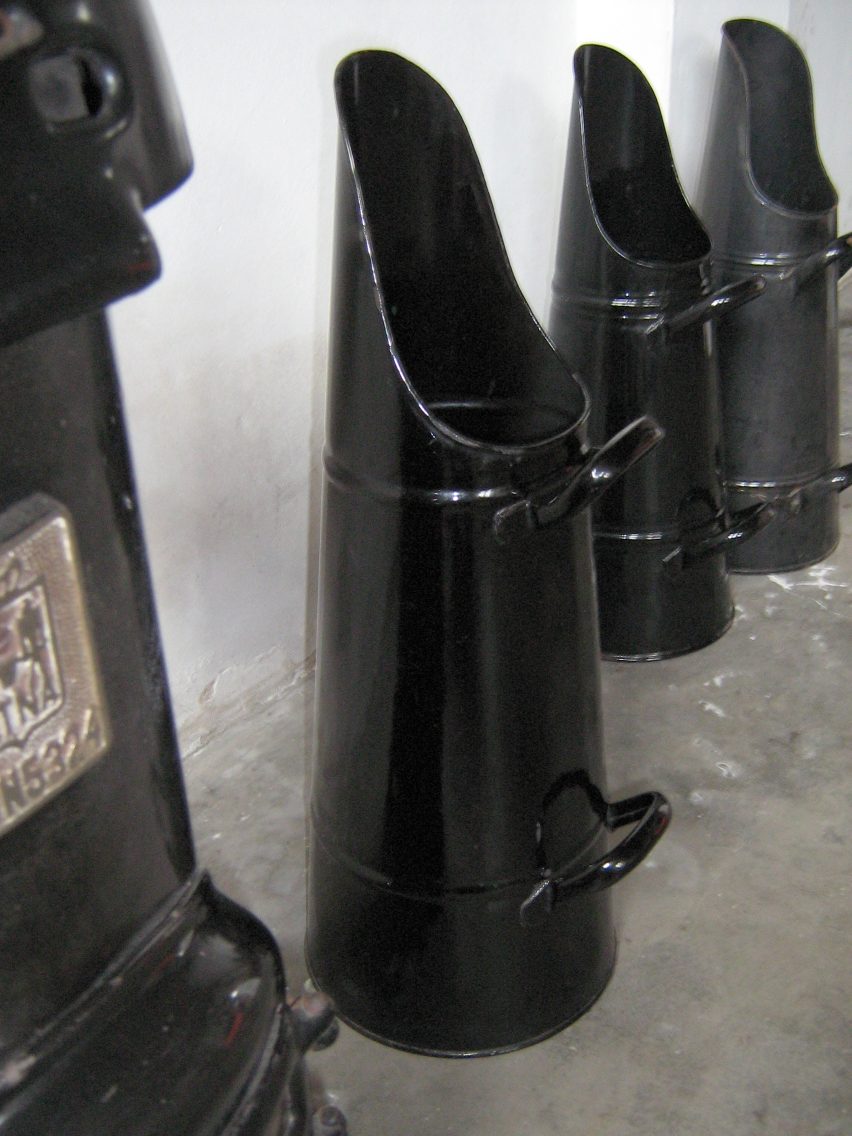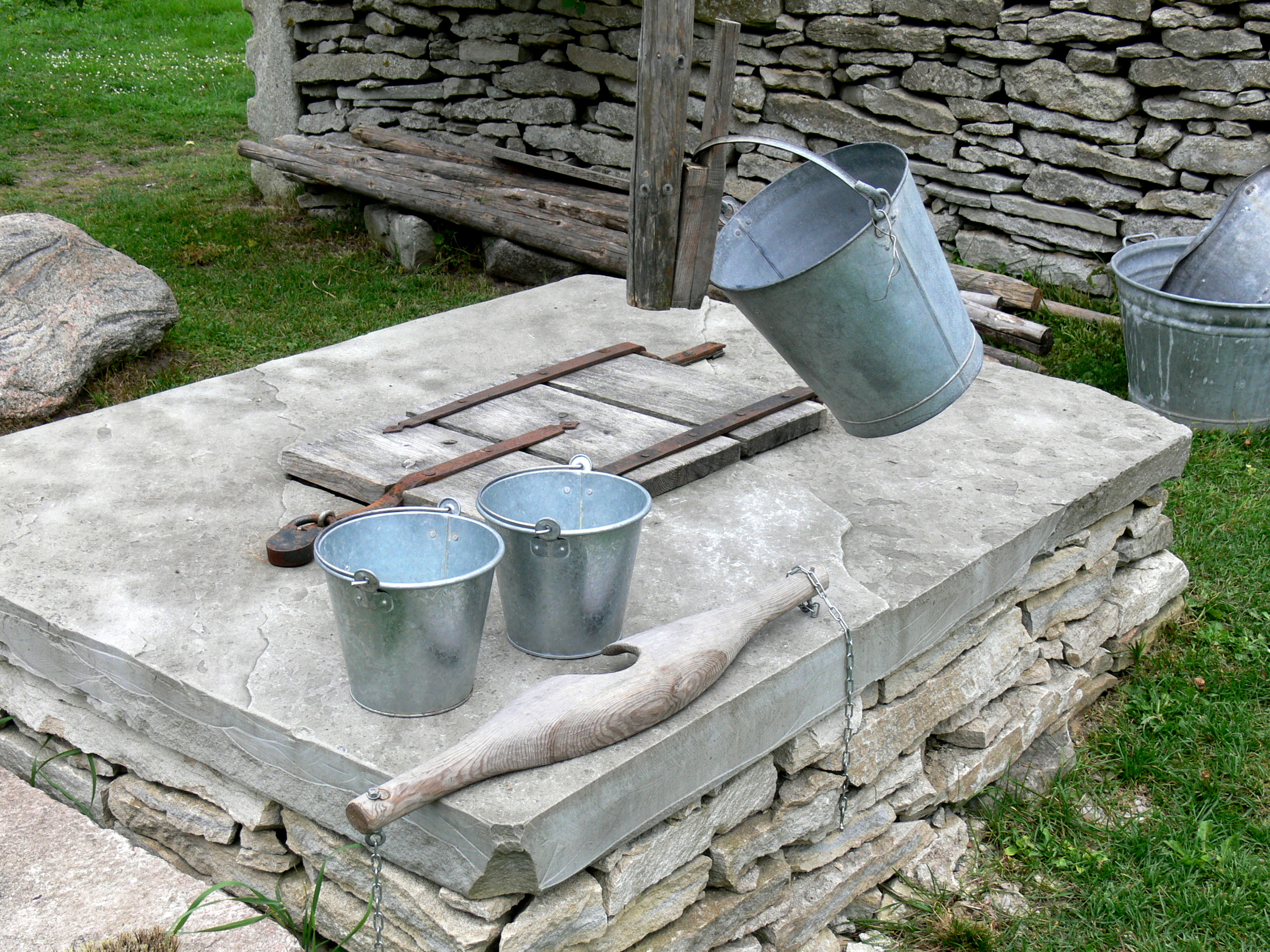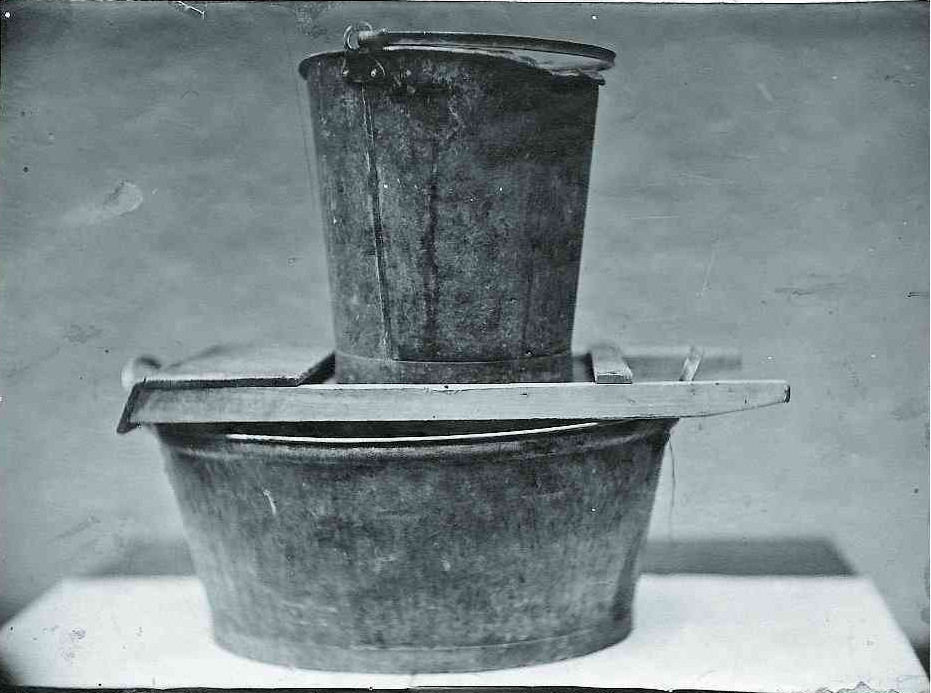|
Coal Scuttle
A coal scuttle, sometimes spelled ''coalscuttle'' and also called a ''hod'', "coal bucket", or "coal pail", is a bucket-like container for holding a small, intermediate supply of coal convenient to an indoor coal-fired stove or heater. Description Coal scuttles are usually made of metal and shaped as a vertical cylinder or truncated cone, with the open top slanted for pouring coal on a fire. It may have one or two handles. Homes that do not use coal sometimes use a coal scuttle decoratively. Origin The word ''scuttle'' comes, via Middle English and Old English, from the Latin word ''scutulla'', meaning "serving platter". An alternative name, ''hod'', derives from the Old French ''hotte'', meaning basket to carry on the back', apparently from Frankish *hotta or some other Germanic source (compare Middle High German hotze 'cradle')", and is also used in reference to boxes used to carry bricks or other construction materials. Infamous use In 1917, the Swedish serial killer Hilda ... [...More Info...] [...Related Items...] OR: [Wikipedia] [Google] [Baidu] |
Kolenkit
Kolenkit District ( Dutch: Kolenkitbuurt) is a neighbourhood in Amsterdam, Netherlands. In 2009 Eberhard van der Laan, the Minister of Housing, referred to the neighborhood as the worst in his "40 problem neighbourhoods" list. Since 2009, major improvements have been made to the neighborhood, by demolishing apartments blocks which were too small and not built to the current standard, and replacing them with newly built, more spacious housing. This program will continue to run until (at least) 202Link Cascoland, a small international network of artists, architects and designers formed by Dutch community artists Fiona Bell and Roel Schoenmakers, won a tender to start a process of empowerment in the Kolenkitbuurt. Since 2010 they organised playful activities and created a labyrinth of fences and four mobile hen houses which served as a meeting place, helping residents to initiate and manage their own projects in an urban revival process. [...More Info...] [...Related Items...] OR: [Wikipedia] [Google] [Baidu] |
Coal Scuttle (PSF)
A coal scuttle, sometimes spelled ''coalscuttle'' and also called a ''hod'', "coal bucket", or "coal pail", is a bucket-like container for holding a small, intermediate supply of coal convenient to an indoor coal-fired stove or heater. Description Coal scuttles are usually made of metal and shaped as a vertical cylinder or truncated cone, with the open top slanted for pouring coal on a fire. It may have one or two handles. Homes that do not use coal sometimes use a coal scuttle decoratively. Origin The word ''scuttle'' comes, via Middle English and Old English, from the Latin word ''scutulla'', meaning "serving platter". An alternative name, ''hod'', derives from the Old French ''hotte'', meaning basket to carry on the back', apparently from Frankish *hotta or some other Germanic source (compare Middle High German hotze 'cradle')", and is also used in reference to boxes used to carry bricks or other construction materials. Infamous use In 1917, the Swedish serial killer Hilda ... [...More Info...] [...Related Items...] OR: [Wikipedia] [Google] [Baidu] |
Bucket
A bucket is typically a watertight, vertical cylinder or truncated cone or square, with an open top and a flat bottom, attached to a semicircular carrying handle called the ''bail''. A bucket is usually an open-top container. In contrast, a pail can have a top or lid and is a shipping container. In common usage, the two terms are often used interchangeably. Types and uses A number of bucket types exist, used for a variety of purposes. Though most of these are functional purposes, a number, including those constructed from precious metals, are used for ceremonial purposes. Common types of bucket and their adjoining purposes include: * Water buckets used to carry water * Household and garden buckets used for carrying liquids and granular products * Elaborate ceremonial or ritual buckets constructed of bronze, ivory or other materials, found in several ancient or medieval cultures, sometimes known by the Latin for bucket, * Large scoops or buckets attached to loaders and teleha ... [...More Info...] [...Related Items...] OR: [Wikipedia] [Google] [Baidu] |
Packaging
Packaging is the science, art and technology of enclosing or protecting products for distribution, storage, sale, and use. Packaging also refers to the process of designing, evaluating, and producing packages. Packaging can be described as a coordinated system of preparing goods for transport, warehousing, logistics, sale, and end use. Packaging contains, protects, preserves, transports, informs, and sells. In many countries it is fully integrated into government, business, institutional, industrial, and personal use. Package labeling (American English) or labelling (British English) is any written, electronic, or graphic communication on the package or on a separate but associated label. History of packaging Ancient era The first packages used the natural materials available at the time: baskets of reeds, wineskins ( bota bags), wooden boxes, pottery vases, ceramic amphorae, wooden barrels, woven bags, etc. Processed materials were used to form packages as they were ... [...More Info...] [...Related Items...] OR: [Wikipedia] [Google] [Baidu] |
Coal
Coal is a combustible black or brownish-black sedimentary rock, formed as stratum, rock strata called coal seams. Coal is mostly carbon with variable amounts of other Chemical element, elements, chiefly hydrogen, sulfur, oxygen, and nitrogen. Coal is formed when dead plant matter decays into peat and is converted into coal by the heat and pressure of deep burial over millions of years. Vast deposits of coal originate in former wetlands called coal forests that covered much of the Earth's tropical land areas during the late Carboniferous (Pennsylvanian (geology), Pennsylvanian) and Permian times. Many significant coal deposits are younger than this and originate from the Mesozoic and Cenozoic eras. Coal is used primarily as a fuel. While coal has been known and used for thousands of years, its usage was limited until the Industrial Revolution. With the invention of the steam engine, coal consumption increased. In 2020, coal supplied about a quarter of the world's primary energ ... [...More Info...] [...Related Items...] OR: [Wikipedia] [Google] [Baidu] |
At Berrington Hall 2022 061
AT or at may refer to: Geography Austria * Austria (ISO 2-letter country code) * .at, Internet country code top-level domain United States * Atchison County, Kansas (county code) * The Appalachian Trail (A.T.), a 2,180+ mile long mountainous trail in the Eastern United States Elsewhere * Anguilla (World Meteorological Organization country code) * Ashmore and Cartier Islands (FIPS 10-4 territory code, and obsolete NATO country code) * At, Bihar, village in Aurangabad district of Bihar, India * Province of Asti, Italy (ISO 3166-2:IT code) Science and technology Computing * @ (or "at sign"), the punctuation symbol now typically used in e-mail addresses and tweets) * at (command), used to schedule tasks or other commands to be performed or run at a certain time * IBM Personal Computer/AT ** AT (form factor) for motherboards and computer cases ** AT connector, a five-pin DIN connector for a keyboard * The Hayes command set for computer modems (each command begins with ... [...More Info...] [...Related Items...] OR: [Wikipedia] [Google] [Baidu] |
Cylinder (geometry)
A cylinder (from ) has traditionally been a three-dimensional solid, one of the most basic of curvilinear geometric shapes. In elementary geometry, it is considered a prism with a circle as its base. A cylinder may also be defined as an infinite curvilinear surface in various modern branches of geometry and topology. The shift in the basic meaning—solid versus surface (as in ball and sphere)—has created some ambiguity with terminology. The two concepts may be distinguished by referring to solid cylinders and cylindrical surfaces. In the literature the unadorned term cylinder could refer to either of these or to an even more specialized object, the ''right circular cylinder''. Types The definitions and results in this section are taken from the 1913 text ''Plane and Solid Geometry'' by George Wentworth and David Eugene Smith . A ' is a surface consisting of all the points on all the lines which are parallel to a given line and which pass through a fixed plane curv ... [...More Info...] [...Related Items...] OR: [Wikipedia] [Google] [Baidu] |
Truncation (geometry)
In geometry, a truncation is an operation in any dimension that cuts polytope vertices, creating a new facet in place of each vertex. The term originates from Kepler's names for the Archimedean solids. Uniform truncation In general any polyhedron (or polytope) can also be truncated with a degree of freedom as to how deep the cut is, as shown in Conway polyhedron notation truncation operation. A special kind of truncation, usually implied, is a uniform truncation, a truncation operator applied to a regular polyhedron (or regular polytope) which creates a resulting uniform polyhedron (uniform polytope) with equal edge lengths. There are no degrees of freedom, and it represents a fixed geometric, just like the regular polyhedra. In general all single ringed uniform polytopes have a uniform truncation. For example, the icosidodecahedron, represented as Schläfli symbols r or \begin 5 \\ 3 \end, and Coxeter-Dynkin diagram or has a uniform truncation, the truncated icosidodecahedr ... [...More Info...] [...Related Items...] OR: [Wikipedia] [Google] [Baidu] |
Cone (geometry)
A cone is a three-dimensional geometric shape that tapers smoothly from a flat base (frequently, though not necessarily, circular) to a point called the apex or vertex. A cone is formed by a set of line segments, half-lines, or lines connecting a common point, the apex, to all of the points on a base that is in a plane that does not contain the apex. Depending on the author, the base may be restricted to be a circle, any one-dimensional quadratic form in the plane, any closed one-dimensional figure, or any of the above plus all the enclosed points. If the enclosed points are included in the base, the cone is a solid object; otherwise it is a two-dimensional object in three-dimensional space. In the case of a solid object, the boundary formed by these lines or partial lines is called the ''lateral surface''; if the lateral surface is unbounded, it is a conical surface. In the case of line segments, the cone does not extend beyond the base, while in the case of hal ... [...More Info...] [...Related Items...] OR: [Wikipedia] [Google] [Baidu] |
Hilda Nilsson
Hilda Nilsson (24 May 1876 – 10 August 1917) was a Swedish serial killer from Helsingborg who became known as "the angel maker on Bruks Street". She is one of Sweden's most notorious female serial killers. In 1917, she was imprisoned for murdering eight children. Her trial, which included a mental examination, began on 2 June 1917. At the conclusion of the trial on 15 June 1917, she was sentenced to death. She escaped execution punishment by committing suicide while in jail in Landskrona. She hanged herself with a linen cloth, which she had tied to a cell door, and was thus the last person sentenced to death in Sweden not to have the sentence commuted. Background Hilda Nilsson and her husband Gustaf lived in Helsingborg. The couple had accrued large debts and needed a way to pay their bills. As a way to raise cash, Nilsson cared for infants in return for money from unmarried mothers who needed help. At that time, having a child outside of marriage was a shameful moral c ... [...More Info...] [...Related Items...] OR: [Wikipedia] [Google] [Baidu] |
Washboard (laundry)
A washboard is a tool designed for hand washing clothing. With mechanized cleaning of clothing becoming more common by the end of the 20th century, the washboard has become better known for its secondary use as a musical instrument. Description and use The traditional washboard is usually constructed with a rectangular wooden frame in which are mounted a series of ridges or corrugations for the clothing to be rubbed upon. For 19th-century washboards, the ridges were often of wood; by the 20th century, ridges of metal were more common. A "fluted" metal washboard was patented in the United States by Stephen Rust in 1833. Zinc washboards were manufactured in the United States from the middle of the 19th century. In the late 20th century and early 21st century, ridges of galvanized steel are most common, but some modern boards are made of glass. Washboards with brass ridges are still made. Many parts of the world still use washboards for washing clothes. Clothes are soaked in ho ... [...More Info...] [...Related Items...] OR: [Wikipedia] [Google] [Baidu] |

.jpg)




